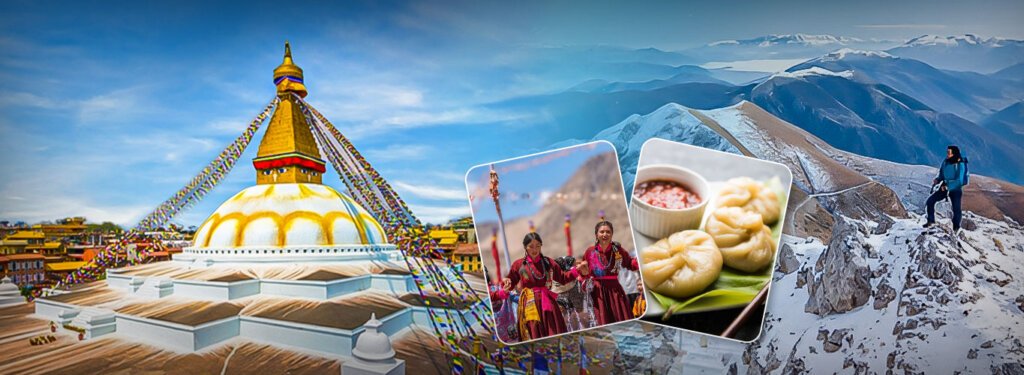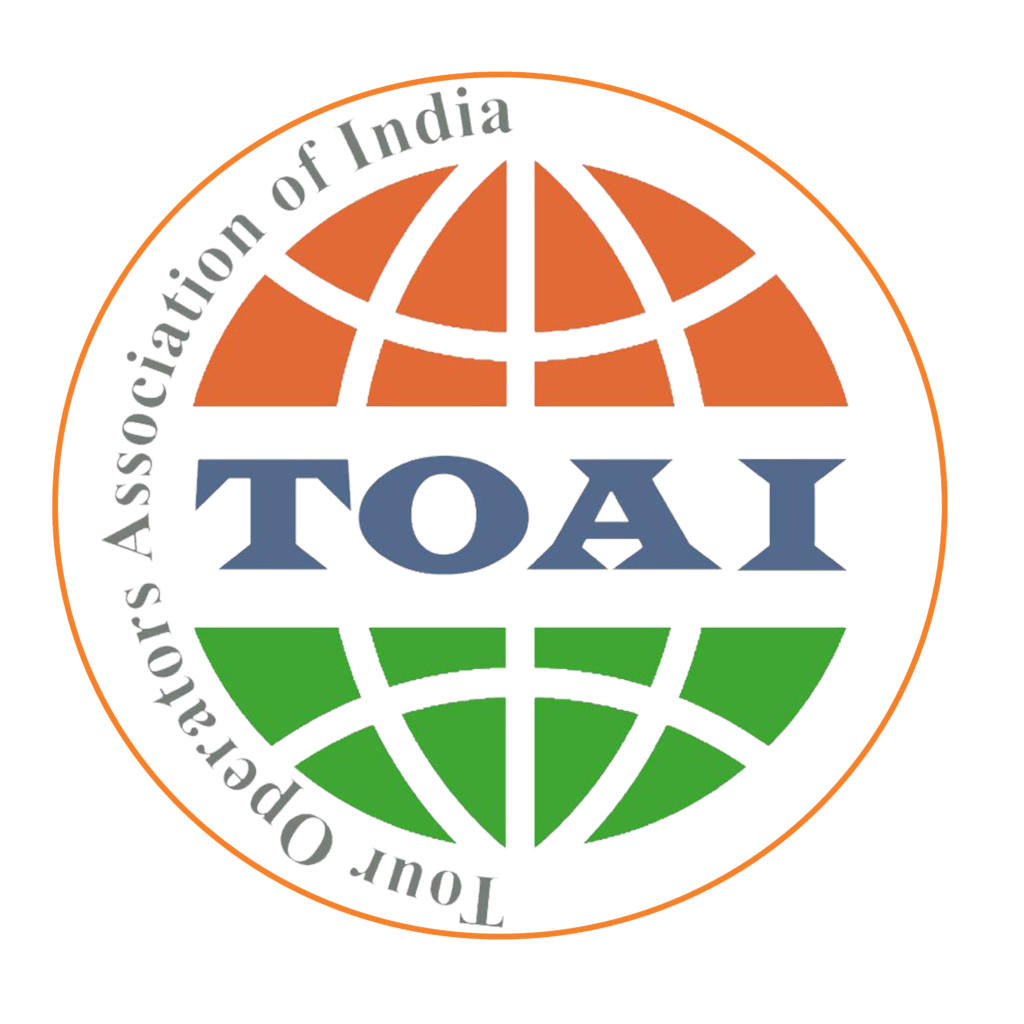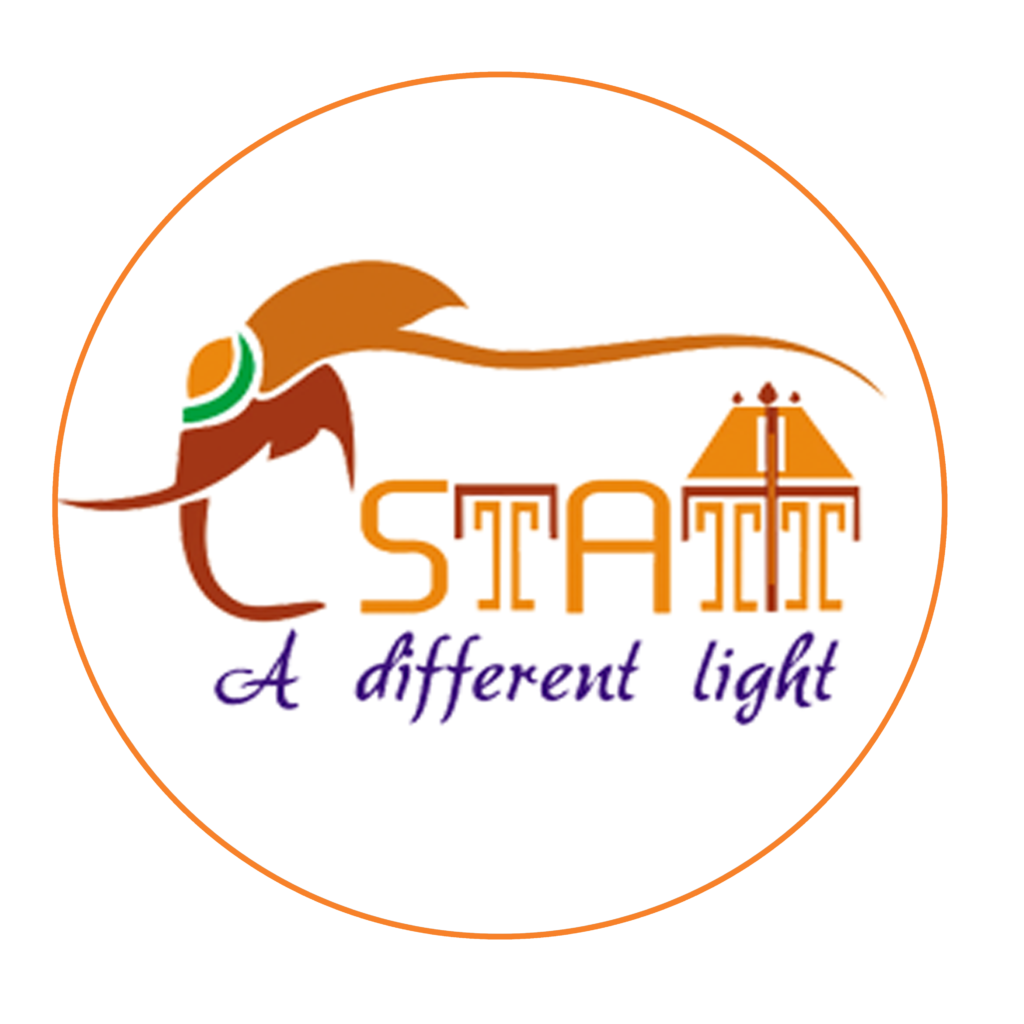
South India's No. 1 Travel Agency ✨
💱 Currency
Nepalese Rupee (NPR)
🗣️ Languages
Nepali (official)
🌤️ Climate
5°C – 30°C
📅 Best Season
March – May (Spring)
September – November (Autumn)
🛡 Must-Know Travel Tips for Visiting Nepal
- 🏧 ATMs are widely available in cities but may be unreliable in remote areas — always carry some cash when traveling to rural regions.
- 💳 Credit and debit cards are accepted at hotels and larger businesses, but cash is preferred for local shops, taxis, and street vendors.
- 🏦 Banks operate Sunday to Friday, usually from 10 AM to 4 PM — avoid banking on Saturdays and public holidays.
- 🍷 The legal drinking age in Nepal is 18, though enforcement may vary in local areas.
- 🤝 Nepali people are warm and hospitable — modest dress and respectful behavior are appreciated, especially in temples and rural villages.
- 💰 Nepal is a budget-friendly destination — for the best trekking and sightseeing weather, travel during spring or autumn.
What Is Nepal Famous For? – About Nepal Explained
Nepal is renowned globally for its breathtaking mountain scenery, vibrant traditions, and thrilling adventure experiences.Many travelers choose Nepal Tour Packages to explore its Himalayan beauty, spiritual landmarks, and wildlife experiences all in one trip.Nestled between India and China, this landlocked Himalayan nation is home to eight of the world’s ten highest peaks, including the legendary Mount Everest (Sagarmatha)—the highest point on Earth. Trekkers, climbers, and adventure seekers from around the globe flock to Nepal for iconic routes like the Everest Base Camp trek, Annapurna Circuit, and Langtang Valley. But Nepal is not just about mountains.While treks like Everest Base Camp, the Annapurna Circuit, and Langtang Valley draw adventurers from around the globe, Nepal offers much more than mountain trails. It’s a land steeped in spirituality and cultural depth — most notably, the birthplace of Lord Buddha in Lumbini, making it a revered pilgrimage site for Buddhists worldwide. The country is dotted with ancient temples, stupas, monasteries, and palaces—many of which are UNESCO World Heritage Sites. In Kathmandu Valley, historic cities like Patan, Bhaktapur, and Kathmandu display stunning Newari architecture, colorful festivals, and bustling bazaars.Nature lovers are drawn to Nepal’s national parks, such as Chitwan and Bardia, where they can go on jungle safaris to see one-horned rhinoceroses, Bengal tigers, elephants, and exotic birds. Adventure activities like white-water rafting, paragliding over Pokhara, bungee jumping, and mountain biking offer plenty of excitement beyond trekking.From serene Himalayan villages to vibrant spiritual traditions, Nepal blends natural wonder with deep-rooted culture, making it one of Asia’s most memorable travel destinations.
Nepal Tour Packages
Most Chosen Nepal Plans by Our Happy Customers
How Are India and Nepal Connected? – Cultural & Historical Ties
India and Nepal share a unique and deep-rooted connection that goes beyond proximity. Their bond is built on centuries of shared culture, religion, language, and open borders. The two countries are linked not only geographically but also through history, tradition, and kinship.
Historically, both nations have been part of the same cultural sphere, with Hinduism and Buddhism shaping the ethos of society in both places. Many gods, festivals, and religious rituals are observed similarly on both sides of the border. For instance, the worship of Lord Shiva, Durga, and Vishnu is widespread, and festivals like Dashain (similar to Dussehra) and Tihar (Diwali) are celebrated with equal fervor.The birthplace of Lord Buddha, Lumbini in Nepal, is a site of major importance for Indian pilgrims and Buddhists worldwide. Likewise, Indian spiritual and educational traditions have had significant influence in Nepal over the centuries. Sanskrit, yoga, Vedic philosophy, and Ayurveda all form part of Nepalese scholarly and spiritual life.India and Nepal maintain an open-border agreement, enabling citizens from both nations to freely live, work, and travel across each other’s borders without the need for a visa.This has resulted in strong economic and people-to-people ties. Indian currency and pop culture (like Bollywood movies and music) are quite popular in Nepal, while Nepalese cuisine, arts, and handicrafts are appreciated in India. Furthermore, intermarriages, cultural exchange programs, and cross-border festivals strengthen the emotional bond between the two nations. From trade and tourism to religion and family, the connection between India and Nepal remains one of friendship, cooperation, and shared heritage.
Interesting Things to Know About Nepal Before You Go
Before you visit Nepal, it’s helpful to understand some of the unique features and local customs that make the country such a special place. Geography and climate are diverse. From the lowland jungles of the Terai to the icy heights of the Himalayas, Nepal has an extreme range of altitudes. This means that while it’s snowing in the north, it can be sunny and warm in the south. The best times to visit are during the spring (March–May) and autumn (September–November) when the weather is mild and the skies are clear—ideal for trekking and sightseeing. Nepalese people are known for their hospitality and humility. The traditional greeting “Namaste,” expressed with a gentle bow and hands pressed together, symbolizes mutual respect and peaceful intentions. Modest dress and respectful behavior, especially at religious sites, are highly appreciated. Removing shoes before entering homes or temples is a common practice. Nepal is a multi-religious and multi-ethnic country, and this is reflected in its food, festivals, and languages. While Nepali is the official language, many locals speak regional tongues like Newari, Maithili, or Tamang. English is widely understood in tourist areas, so communication is rarely an issue for visitors. ATMs are available in towns like Kathmandu and Pokhara. It’s important to note that bargaining is common in local markets, especially when shopping for handicrafts, pashmina, or souvenirs.Getting around Nepal often feels like an adventure of its own, with scenic routes and unpredictable journeys adding to the experience. Roads may be bumpy, and travel times can be longer than expected. However, domestic flights are available to reach places like Pokhara or Lukla (gateway to Everest).Finally, Nepal is a safe and peaceful country, especially for solo travelers and women. Just be mindful of altitude sickness when trekking, and always check the weather and health guidelines if heading to remote areas.From sacred temples to snow-capped peaks, and jungle safaris to spicy momos, Nepal is full of surprises—and understanding a few things beforehand can make your trip even more enjoyable.
What to Know Before Booking a Nepal Tour Package
Booking a Nepal tour package is the first step toward discovering one of the most culturally rich and naturally breathtaking destinations in South Asia. But before confirming your travel plan, there are several important factors to consider that can significantly shape your experience.
First, understand the type of experience you’re looking for. Nepal offers everything from spiritual and cultural journeys to adventure-packed treks. Packages range from heritage tours in Kathmandu Valley to high-altitude trekking in regions like Everest, Annapurna, and Langtang. Whether you’re a nature enthusiast, a cultural explorer, or a spiritual seeker, your ideal itinerary will depend on the purpose of your visit and your physical preparedness—especially if you’re including hikes or treks.Next, check the season. The best time to visit Nepal is during the pre-monsoon (March to May) and post-monsoon (September to November) seasons. However, if you’re visiting for cultural experiences or festivals like Dashain or Tihar, the timing may vary slightly.Pay attention to what’s included in the tour package—some include domestic flights, permits (for treks or conservation areas), meals, porters, guides, and entrance fees, while others may not. Always verify if airport transfers, accommodation categories, and support staff are covered. For trekking tours, it’s essential to ensure the package includes acclimatization days and emergency support (like evacuation services).While Nepal is generally very affordable, costs can vary depending on transportation, travel style, and altitude. Book through reputed tour operators who are licensed and have strong reviews. This ensures quality service, reliable guides, and ethical practices, especially for treks involving local porters.Lastly, understand visa regulations. Most nationalities, including Indian citizens, enjoy visa-free or visa-on-arrival access to Nepal, making travel easy and accessible. Travel insurance is highly recommended, especially if your tour includes adventure activities or remote trekking.
Which Are the Best Budget Nepal Tour Packages?
Nepal is one of the most budget-friendly travel destinations in the world, and travelers can enjoy a complete experience—scenic landscapes, spiritual sites, cultural depth, and outdoor adventure—without overspending. Several affordable tour packages are designed to give you the essence of Nepal while keeping costs low.For first-time visitors, a Kathmandu–Pokhara–Chitwan circuit is among the most popular and economical. These packages typically span 6 to 8 days and include guided sightseeing in the Kathmandu Valley’s UNESCO World Heritage Sites, a relaxing stay by Phewa Lake in Pokhara, and jungle safaris in Chitwan National Park, where you can spot rhinos, crocodiles, and if lucky, a Bengal tiger.Short trekking packages such as the Ghorepani Poon Hill Trek, the Langtang Valley Trek, or the Nagarkot Hike are excellent for budget-conscious travelers. These treks are accessible, require fewer days, and offer stunning Himalayan views without needing high-altitude preparation. Guesthouses along the trail provide meals and accommodation at low costs, and tour packages often include local transportation and permits.If you’re looking for spiritual or cultural immersion, Buddhist heritage tours covering Lumbini (the birthplace of Lord Buddha), Swayambhunath, and Boudhanath offer affordable insights into Nepal’s rich religious traditions. These packages typically include monastery visits, meditation sessions, and cultural performances.Travelers on a budget can also explore local homestay programs in places like Bandipur, Patan, or Gorkha. These are not only cost-effective but also offer deep cultural engagement and locally cooked meals. Most budget packages include shared transport, English-speaking guides, modest hotels or guesthouses, and daily breakfast. With local meals and low-cost transport options like tourist buses or local flights, Nepal allows travelers to explore deeply while staying within their means.
Quick Facts About Nepal – Geography, Wildlife & People
Nepal is a small yet incredibly diverse country located between India and China, home to an astonishing range of landscapes, cultures, and wildlife. Stretching from the lowland Terai plains to the soaring peaks of the Himalayas, Nepal’s geography alone is enough to amaze.The country is famous for being home to eight of the world’s ten highest mountains, including Mount Everest, the tallest peak on Earth. Its terrain rises dramatically within short distances—traveling from the southern border to the northernmost parts takes you from subtropical jungles to alpine glaciers. The Himalayan region in the north is ideal for trekking and mountaineering, while the central hilly region is dotted with terraced fields, historic cities, and hilltop temples. The southern Terai plains, on the other hand, are rich in agriculture and host Nepal’s most accessible wildlife reserves.In terms of biodiversity, Nepal is incredibly rich for its size. Chitwan National Park and Bardia National Park are home to royal Bengal tigers, one-horned rhinoceroses, leopards, elephants, and mugger crocodiles. The Himalayan foothills also support red pandas, snow leopards, and a variety of bird species—making the country a haven for wildlife enthusiasts and bird watchers. More than 120 ethnic groups and castes coexist, speaking over 100 different languages and dialects. Major communities include the Newars, Tamangs, Gurungs, Sherpas, Tharus, and Maithils—each with their own unique customs, festivals, attire, and cuisine. Despite this diversity, there’s a deep sense of unity and national identity centered around shared respect for nature, religion, and tradition.Nepal is also the birthplace of Lord Buddha, and the country practices both Hinduism and Buddhism in rich harmony. Visitors are welcomed with genuine warmth, and traditional hospitality is an essential part of Nepali culture. Whether you’re hiking in the Himalayas or walking through a bustling market in Bhaktapur, the friendliness of the local people leaves a lasting impression.
Including experiences like wildlife safaris, high-altitude trekking, and cultural immersion in your Nepal tour plan ensures a truly well-rounded and unforgettable journey through this captivating Himalayan country.
Nepal Tour Packages
| High Season | March to May (Spring), September to November (Autumn) |
|---|---|
| Iconic Attractions | Mount Everest, Pashupatinath Temple, Boudhanath Stupa, Pokhara Valley, Chitwan National Park |
| Popular Activities | Trekking in the Himalayas, Paragliding in Pokhara, Jungle Safaris, Temple Visits |
| Visa | Visa on arrival available for most nationalities (check latest guidelines before travel) |
| National Animal | Cow |
| National Flower | Rhododendron |
| Famous Food | Momo, Dal Bhat, Sel Roti, Yomari, Chatamari, Gundruk |
How Are India and Nepal Connected? – Cultural & Historical Ties
India and Nepal share a unique and deep-rooted connection that goes beyond proximity. Their bond is built on centuries of shared culture, religion, language, and open borders. The two countries are linked not only geographically but also through history, tradition, and kinship.
Historically, both nations have been part of the same cultural sphere, with Hinduism and Buddhism shaping the ethos of society in both places. Many gods, festivals, and religious rituals are observed similarly on both sides of the border. For instance, the worship of Lord Shiva, Durga, and Vishnu is widespread, and festivals like Dashain (similar to Dussehra) and Tihar (Diwali) are celebrated with equal fervor.The birthplace of Lord Buddha, Lumbini in Nepal, is a site of major importance for Indian pilgrims and Buddhists worldwide. Likewise, Indian spiritual and educational traditions have had significant influence in Nepal over the centuries. Sanskrit, yoga, Vedic philosophy, and Ayurveda all form part of Nepalese scholarly and spiritual life.India and Nepal maintain an open-border agreement, enabling citizens from both nations to freely live, work, and travel across each other’s borders without the need for a visa.This has resulted in strong economic and people-to-people ties. Indian currency and pop culture (like Bollywood movies and music) are quite popular in Nepal, while Nepalese cuisine, arts, and handicrafts are appreciated in India. Furthermore, intermarriages, cultural exchange programs, and cross-border festivals strengthen the emotional bond between the two nations. From trade and tourism to religion and family, the connection between India and Nepal remains one of friendship, cooperation, and shared heritage.
Interesting Things to Know About Nepal Before You Go
Before you visit Nepal, it’s helpful to understand some of the unique features and local customs that make the country such a special place. Geography and climate are diverse. From the lowland jungles of the Terai to the icy heights of the Himalayas, Nepal has an extreme range of altitudes. This means that while it’s snowing in the north, it can be sunny and warm in the south. The best times to visit are during the spring (March–May) and autumn (September–November) when the weather is mild and the skies are clear—ideal for trekking and sightseeing. Nepalese people are known for their hospitality and humility. The traditional greeting “Namaste,” expressed with a gentle bow and hands pressed together, symbolizes mutual respect and peaceful intentions. Modest dress and respectful behavior, especially at religious sites, are highly appreciated. Removing shoes before entering homes or temples is a common practice. Nepal is a multi-religious and multi-ethnic country, and this is reflected in its food, festivals, and languages. While Nepali is the official language, many locals speak regional tongues like Newari, Maithili, or Tamang. English is widely understood in tourist areas, so communication is rarely an issue for visitors. ATMs are available in towns like Kathmandu and Pokhara. It’s important to note that bargaining is common in local markets, especially when shopping for handicrafts, pashmina, or souvenirs.Getting around Nepal often feels like an adventure of its own, with scenic routes and unpredictable journeys adding to the experience. Roads may be bumpy, and travel times can be longer than expected. However, domestic flights are available to reach places like Pokhara or Lukla (gateway to Everest).Finally, Nepal is a safe and peaceful country, especially for solo travelers and women. Just be mindful of altitude sickness when trekking, and always check the weather and health guidelines if heading to remote areas.From sacred temples to snow-capped peaks, and jungle safaris to spicy momos, Nepal is full of surprises—and understanding a few things beforehand can make your trip even more enjoyable.
What to Know Before Booking a Nepal Tour Package
Booking a tour package to Nepal is the first step toward discovering one of the most culturally rich and naturally breathtaking destinations in South Asia. But before confirming your travel plan, there are several important factors to consider that can significantly shape your experience.
First, understand the type of experience you’re looking for. Nepal offers everything from spiritual and cultural journeys to adventure-packed treks. Packages range from heritage tours in Kathmandu Valley to high-altitude trekking in regions like Everest, Annapurna, and Langtang. Whether you’re a nature enthusiast, a cultural explorer, or a spiritual seeker, your ideal itinerary will depend on the purpose of your visit and your physical preparedness—especially if you’re including hikes or treks.Next, check the season. The best time to visit Nepal is during the pre-monsoon (March to May) and post-monsoon (September to November) seasons. However, if you’re visiting for cultural experiences or festivals like Dashain or Tihar, the timing may vary slightly.Pay attention to what’s included in the tour package—some include domestic flights, permits (for treks or conservation areas), meals, porters, guides, and entrance fees, while others may not. Always verify if airport transfers, accommodation categories, and support staff are covered. For trekking tours, it’s essential to ensure the package includes acclimatization days and emergency support (like evacuation services).While Nepal is generally very affordable, costs can vary depending on transportation, travel style, and altitude. Book through reputed tour operators who are licensed and have strong reviews. This ensures quality service, reliable guides, and ethical practices, especially for treks involving local porters.Lastly, understand visa regulations. Most nationalities, including Indian citizens, enjoy visa-free or visa-on-arrival access to Nepal, making travel easy and accessible. Travel insurance is highly recommended, especially if your tour includes adventure activities or remote trekking.
Which Are the Best Budget Nepal Tour Packages?
Nepal is one of the most budget-friendly travel destinations in the world, and travelers can enjoy a complete experience—scenic landscapes, spiritual sites, cultural depth, and outdoor adventure—without overspending. Several affordable tour packages are designed to give you the essence of Nepal while keeping costs low.For first-time visitors, a Kathmandu–Pokhara–Chitwan circuit is among the most popular and economical. These packages typically span 6 to 8 days and include guided sightseeing in the Kathmandu Valley’s UNESCO World Heritage Sites, a relaxing stay by Phewa Lake in Pokhara, and jungle safaris in Chitwan National Park, where you can spot rhinos, crocodiles, and if lucky, a Bengal tiger.Short trekking packages such as the Ghorepani Poon Hill Trek, the Langtang Valley Trek, or the Nagarkot Hike are excellent for budget-conscious travelers. These treks are accessible, require fewer days, and offer stunning Himalayan views without needing high-altitude preparation. Guesthouses along the trail provide meals and accommodation at low costs, and tour packages often include local transportation and permits.If you’re looking for spiritual or cultural immersion, Buddhist heritage tours covering Lumbini (the birthplace of Lord Buddha), Swayambhunath, and Boudhanath offer affordable insights into Nepal’s rich religious traditions. These packages typically include monastery visits, meditation sessions, and cultural performances.Travelers on a budget can also explore local homestay programs in places like Bandipur, Patan, or Gorkha. These are not only cost-effective but also offer deep cultural engagement and locally cooked meals. Most budget packages include shared transport, English-speaking guides, modest hotels or guesthouses, and daily breakfast. With local meals and low-cost transport options like tourist buses or local flights, Nepal allows travelers to explore deeply while staying within their means.
Quick Facts About Nepal – Geography, Wildlife & People
Nepal is a small yet incredibly diverse country located between India and China, home to an astonishing range of landscapes, cultures, and wildlife. Stretching from the lowland Terai plains to the soaring peaks of the Himalayas, Nepal’s geography alone is enough to amaze.The country is famous for being home to eight of the world’s ten highest mountains, including Mount Everest, the tallest peak on Earth. Its terrain rises dramatically within short distances—traveling from the southern border to the northernmost parts takes you from subtropical jungles to alpine glaciers. The Himalayan region in the north is ideal for trekking and mountaineering, while the central hilly region is dotted with terraced fields, historic cities, and hilltop temples. The southern Terai plains, on the other hand, are rich in agriculture and host Nepal’s most accessible wildlife reserves.In terms of biodiversity, Nepal is incredibly rich for its size. Chitwan National Park and Bardia National Park are home to royal Bengal tigers, one-horned rhinoceroses, leopards, elephants, and mugger crocodiles. The Himalayan foothills also support red pandas, snow leopards, and a variety of bird species—making the country a haven for wildlife enthusiasts and bird watchers. More than 120 ethnic groups and castes coexist, speaking over 100 different languages and dialects. Major communities include the Newars, Tamangs, Gurungs, Sherpas, Tharus, and Maithils—each with their own unique customs, festivals, attire, and cuisine. Despite this diversity, there’s a deep sense of unity and national identity centered around shared respect for nature, religion, and tradition.Nepal is also the birthplace of Lord Buddha, and the country practices both Hinduism and Buddhism in rich harmony. Visitors are welcomed with genuine warmth, and traditional hospitality is an essential part of Nepali culture. Whether you’re hiking in the Himalayas or walking through a bustling market in Bhaktapur, the friendliness of the local people leaves a lasting impression.
Including experiences like wildlife safaris, high-altitude trekking, and cultural immersion in your Nepal tour plan ensures a truly well-rounded and unforgettable journey through this captivating Himalayan country.
Nepal Tour Packages
| Kathmandu | Swayambhunath (Monkey Temple), Pashupatinath Temple, Boudhanath Stupa, Durbar Square |
|---|---|
| Pokhara | Phewa Lake, World Peace Pagoda, Davis Falls, Paragliding, Mountain Views |
| Chitwan | Chitwan National Park, Jungle Safari, Elephant Breeding Center, Canoe Rides, Tharu Cultural Dance |
| Lumbini | Maya Devi Temple, Ashoka Pillar, Monastic Zone, Birthplace of Buddha, Sacred Garden |
| Nagarkot | Panoramic Himalayan Views, Sunrise & Sunset Short Hikes, Peaceful Resorts |
| Everest Region | Mount Everest, Namche Bazaar, Tengboche Monastery, Trekking Routes, Base Camp |
| Bhaktapur | Bhaktapur Durbar Square, Nyatapola Temple, Pottery Square, Rich Medieval Culture |
What Should Indian Travellers Know Before Visiting Nepal?
Indian travelers will find Nepal to be one of the most accessible and friendly international destinations. The entry process is smooth—Indian citizens do not need a visa to visit Nepal and can travel using a valid Indian passport, voter ID card, or even an Aadhaar card for land crossings. Flights from major Indian cities to Kathmandu are frequent, and overland travel is also possible through well-connected border points like Raxaul–Birgunj and Sunauli–Bhairahawa.The official currency in Nepal is the Nepalese Rupee (NPR). While Indian Rupees are accepted in many shops and hotels, denominations of ₹500 and ₹2,000 are restricted, so it’s best to carry ₹100 notes or exchange your currency at authorized counters. In tourist hubs, credit and debit cards are commonly accepted, but it’s advisable to keep cash on hand, especially in rural or market areas.Language is rarely a barrier—Hindi is widely understood, and English is commonly spoken in cities and among younger locals. Nepal’s cultural and religious landscape feels familiar to Indian travelers, with shared traditions in Hinduism and Buddhism, as well as similarities in festivals, temple rituals, and food habits. However, visitors should dress modestly, particularly when visiting monasteries or sacred temples, and be mindful of local customs and etiquette.Travel across Nepal ranges from domestic flights and tourist buses to local taxis and shared jeeps. Though scenic, road conditions in hilly areas may be rough and time-consuming. It is also highly recommended to carry travel insurance, especially for high-altitude trekking or adventure sports. Indian visitors should also be cautious about altitude sickness when traveling to elevated regions like Mustang or Everest Base Camp and ensure proper acclimatization. Nepal offers Indian tourists the joy of discovering another country with a deep cultural connection and without complicated paperwork.
Where to Shop in Nepal – Best Markets & Souvenirs
Shopping in Nepal is a colorful and exciting experience that reflects the country’s vibrant culture and skilled craftsmanship. In Kathmandu, the bustling neighborhood of Thamel is a shopper’s paradise, filled with everything from Tibetan singing bowls and handmade notebooks to brass statues, prayer wheels, and pashmina shawls. The atmosphere is lively, and bargaining is part of the experience, especially in souvenir shops and street markets.For more authentic and traditional purchases, Patan is the ideal spot. Known for its exquisite metal crafts and spiritual art, the area is rich with workshops where artisans create statues of deities and detailed thangka paintings. These pieces are more than decorative—they are deeply spiritual and often handcrafted by generations of Newar craftsmen. Nearby Bhaktapur is also worth visiting for its pottery markets, where clay items are made and fired in open squares, and for its impressive wood carvings and cultural souvenirs.Nestled along the serene shores of Phewa Lake, it offers woolen clothes, local artwork, silver jewelry, trekking gear, and traditional Gurkha knives (kukris). The relaxed setting of Pokhara makes shopping there a more leisurely experience. Across all major cities, you’ll also find a selection of local herbal products, incense sticks, and teas from Ilam, Nepal’s tea-growing region.When shopping in Nepal, always confirm whether a product is handmade or factory-produced, particularly when it comes to textiles and artwork. Some higher-end stores offer certification for genuine handicrafts. Most smaller shops prefer cash, though larger outlets may accept cards. Beyond buying gifts and souvenirs, shopping in Nepal allows visitors to engage directly with artisans and carry a piece of Nepal’s tradition and creativity back home.
How Is the Art and Culture Scene in Nepal?
Nepal’s art and culture scene is a vibrant tapestry woven from centuries of spiritual heritage, ethnic diversity, and timeless craftsmanship. Throughout the country, culture is not just observed—it is lived through rituals, festivals, music, architecture, and artisan traditions passed down over generations. Kathmandu Valley is the epicenter of Nepalese art, where ancient cities like Patan, Bhaktapur, and Kathmandu showcase architectural marvels, stone carvings, and intricately designed temples. The work of Newar artisans—renowned for metal sculpting, thangka painting, and wood carving—is visible in every corner of these heritage zones. Their creativity is not only artistic but spiritual, often representing deities, mandalas, and religious stories through their craft. Cultural festivals are major highlights that reflect the country’s multiethnic identity. Celebrations like Dashain, Tihar, Indra Jatra, and Losar bring together music, dance, traditional dress, and ritual performances in lively processions. Folk music, using instruments like the sarangi and madal, is an integral part of Nepali life and varies from region to region, often telling stories of love, struggle, or spirituality.Kathmandu is now home to modern galleries, creative workshops, and cultural hubs where traditional styles meet modern expression. Places like Siddhartha Art Gallery and the Taragaon Museum are popular for experiencing the evolving artistic dialogue in Nepal. Street art, handicraft markets, and public performances further contribute to Nepal’s thriving cultural landscape. Whether you’re watching a masked dance in Bhaktapur, visiting a woodcarver’s home in Patan, or attending a musical show in Pokhara, you’re stepping into a living museum of Nepalese heritage.Many travelers now design their Nepal tour plan to include hands-on cultural experiences such as pottery making, cooking classes, or traditional music lessons—ensuring their journey is both immersive and memorable. From the sacred to the creative, Nepal’s art and culture offer a deeply enriching connection for every visitor.













